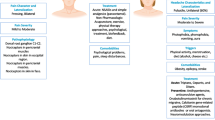Abstract
Primary headache disorders include tension-type headache and migraine. These headache types can be differentiated based on strict clinical definitions that depend on the patient’s signs and symptoms. However, some of the clinical features can overlap, and in addition, the same comorbid conditions can occur in both headache types. Distinction between these headache types on occasion can be difficult due to comorbid conditions such as temporomandibular joint disorders and myofascial pain with forward head posturing, which may be present in both headache disorders, and thus result in similar features in both conditions. Furthermore, chronification, particularly of migraine, leads to a decrease in the associated symptoms of migraine, such as nausea, photophobia, and phonophobia, so that these headaches more closely resemble tension-type headache. Finally, in some patients, both tension-type headache and migraine may occur at different times.
Similar content being viewed by others
References
Papers of particular interest, published recently, have been highlighted as: •• Of major importance
Silberstein SD, Olesen J, Bousser MG, et al.: The International Classification of Headache Disorders, 2nd Edition (ICHD-II): revision of criteria for 8.2 Medication-overuse headache. Cephalalgia 2005, 25:460–465. (Published erratum appears in Cephalalgia 2006, 26:360.)
Verri AP, Proietti Cecchini A, Galli C, et al.: Psychiatric comorbidity in chronic daily headache. Cephalalgia 1998, 18(Suppl 21):45–49.
•• Kaniecki RG: Patient-Assessed Neck Tenderness Predicts Migraine Response to Triptans. Headache 2007, 47:748. This study demonstrated that, among migraine patients, those with significant neck pain and tenderness responded better to triptan therapy than those without this symptom.
Kaniecki RG: Migraine and tension-type headache: an assessment of challenges in diagnosis. Neurology 2002, 58(9 Suppl 6):S15–S20.
Watson DH, Trott PH: Cervical headache: an investigation of natural head posture and upper cervical flexor muscle performance. Cephalalgia 1993, 13:272–284.
Fernández-de-las-Peñas C, Alonso-Blanco C, Cuadrado ML, Pareja JA: Forward head posture and neck mobility in chronic tension-type headache: a blinded, controlled study. Cephalalgia 2006, 26:314–319.
Pfaffenrath V, Dandekar R, Pöllmann W: Cervicogenic headache: the clinical picture, radiological findings and hypotheses on its pathophysiology. Headache 1987, 27:495–499.
Fernández-de-las-Peñas C, Alonso-Blanco C, Cuadrado ML, et al.: Trigger points in the suboccipital and forward head posture in tension-type headache. Headache 2006, 46:454–460.
Manzoni GC, Torelli P: Chronic migraine and chronic tension-type headache: are they the same or different? Neurol Sci 2009, 30(Suppl 1):S81–S84.
Fernández-de-Las-Peñas C, Cuadrado ML, Pareja JA: Myofascial trigger points, neck mobility and forward head posture in unilateral migraine. Cephalalgia 2006, 26:1061–1070.
Davidoff RA: Trigger points and myofascial pain: toward understanding how they affect headaches. Cephalalgia 1998, 18:436–448.
Bevilaqua-Grossi D, Lipton RB, Napchan U, et al.: Temporomandibular disorders and cutaneous allodynia are associated in individuals with migraine. Cephalalgia 2009 July 9 (Epub ahead of print).
Mitrirattanakul S, Merrill RL: Headache impact in patients with orofacial pain. J Am Dent Assoc 2006, 137:1267–1274.
Merrill RL: Central mechanisms of orofacial pain. Dent Clin North Am 2007, 51:45–59.
Kopp S: The influence of neuropeptides, serotonin, and interleukin 1β on temporomandibular joint pain and inflammation. J Oral Maxillofac Surg 1998, 56:189–191.
Holmlund A, Ekblom A, Hansson P, et al.: Concentrations of neuropeptides substance P, neurokinin A, calcitonin gene-related peptide, neuropeptide Y and vasoactive intestinal polypeptide in synovial fluid of the human temporomandibular joint. A correlation with symptoms, signs and arthroscopic findings. Int J Oral Maxillofac Surg 1991, 20:228–231.
Henry CH, Wolford LM: Substance P and mast cells: preliminary histologic analysis of the human temporomandibular joint. Oral Surg Oral Med Oral Pathol Oral Radiol Endod 2001, 92:384–389.
Sheftell FD, Atlas SJ: Migraine and psychiatric comorbidity: from theory and hypotheses to clinical application. Headache 2002, 42:934–944.
Lipton RB, Stewart WF, Cady R, et al.: 2000 Wolfe Award. Sumatriptan for the range of headaches in migraine sufferers: results of the Spectrum Study. Headache 2000, 40:783–791.
Lipton RB, Cady RK, Stewart WF, et al.: Diagnostic lessons from the spectrum study. Neurology 2002, 58(9 Suppl 6):S27–S31.
Olesen J: Clinical and pathophysiological observations in migraine and tension-type headache explained by integration of vascular, supraspinal and myofascial inputs. Pain 1991, 46:125–132.
Fernández-de-Las-Peñas C, Ge HY, Arendt-Nielsen L, et al.: Referred pain from trapezius muscle trigger points share similar characteristics with chronic tension type headache. Eur J Pain 2007, 11:475–482.
Goadsby PJ: Migraine Pathophysiology. In Headache in Children and Adolescents, edn 1. Edited by Winner P and Rothner AD.BC Decker: Hamilton, Ontario; 2001:47–59.
Bendtsen L: Central sensitization in tension-type headache: possible pathophysiological mechanisms. Cephalalgia 2000, 20:486–508.
Bendtsen L, Jensen R: Tension-type headache. Neurol Clin 2009, 27:525–535.
Jensen R, Rasmussen BK, Pedersen B, Olesen J: Muscle tenderness and pressure pain thresholds in headache. A population study. Pain 1993, 52:193–199.
Fumal A, Shoenen J: Tension-type headache: current research and clinical management. Lancet Neurol 2008, 7:70–83.
•• Cady RK: The convergence hypothesis. Headache 2007, 47(Suppl 1):S44–S51. This paper discusses the similarities between tension-type headaches and migraines, arguing that they occur on an escalating scale. This theory argues that early recognition and treatment of tension-type headache can prevent progression to migraine.
Ashina M, Bendtsen L, Jensen R, et al.: Calcitonin gene-related peptide levels during nitric oxide-induced headache in patients with chronic tension-type headache. Eur J Neurol 2001, 8:173–178.
Disclosures
Dr. Andrew Blumenfeld serves as a consultant for Allergan, MAP Pharmaceuticals, GSK, Pfizer, and Nautilus, and has received honoraria from Allergan, Zogenix, GlaxoSmithKline, Pfizer, Merck and Co, Forrest Pharmaceuticals. Dr. Jack Schim serves as a consultant for Allergan and MAP Pharmaceuticals; has received honoraria from Zogenix, GlaxoSmithKline, Pfizer, Eli Lilly and Co., and Merck and Co.; has received payment for developments of educational presentations from Allergan; and has received travel expense compensation from Allergan and Zogenix. Jessica Brower: none.
Author information
Authors and Affiliations
Corresponding author
Rights and permissions
About this article
Cite this article
Blumenfeld, A., Schim, J. & Brower, J. Pure Tension-type Headache Versus Tension-type Headache in the Migraineur. Curr Pain Headache Rep 14, 465–469 (2010). https://doi.org/10.1007/s11916-010-0147-1
Published:
Issue Date:
DOI: https://doi.org/10.1007/s11916-010-0147-1




